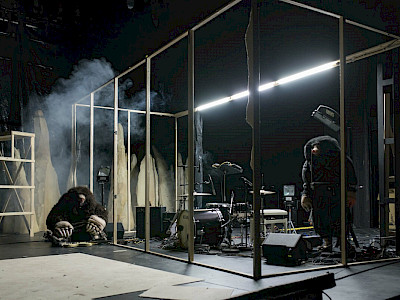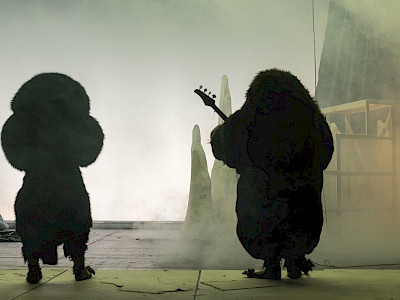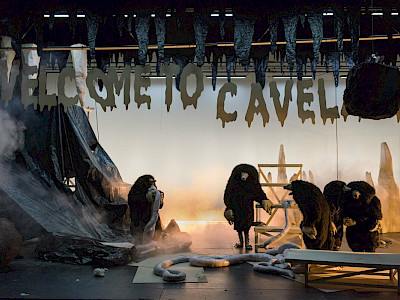06 — 09.05.2016
Philippe Quesne Nanterre
La nuit des taupes
theatre — premiere
French → NL | ⧖ 1h45 | € 20 / € 16 | Meet the artists after the performance on 7/05
Philippe Quesne is a guest of honour at the Kunstenfestivaldesarts this year. The idiosyncratic theatre maker has a visual arts background, and since 2014 has participated in the running of the Théâtre Nanterre-Amandiers. In May 2016, Quesne comes to Brussels with the world premiere of a new piece. La nuit des taupes plunges the audience into a world of allegorical giant moles and other fantastical creatures who have sought refuge there. An arts centre threatened with closure goes underground, into a space that is a cross between a prehistoric settlement, a fallout shelter, and Plato’s cave. In the cave, an ‘ecosophical’ theatre is inscribed, where the human perspective is balanced against that of the animal. With La nuit des taupes, Philippe Quesne links into the genre of social science-fiction. He makes of the theatre a utopian refuge and takes the audience on a journey to the centre of the earth, where dreams can stimulate the consciousness. How does our own world look from the cave?
See also
Welcome to Caveland!
Interview with Philippe Quesne
Is Welcome to Caveland! a sequel to Swamp Club?
As is very often the case with my work, the origins of this project lie at the end of the previous production. Swamp Club involved an arts centre under threat and ended with the performers being evacuated, disappearing into a tunnel for shelter guided by a giant mole… So I wanted to continue the adventure in the cave. Diving underground opens up a range of options and fascinating themes linked to the imaginary underground world, from Plato to Bin Laden with famous places in literature or film in between. I want to question this allegory of the cave. It’s a world that evokes a notion of a refuge, a burrow, a hiding place or a fall-out shelter, indeed even theatre because theatre is a kind of cave art. In the 1950s, when the planet was threatened with nuclear obliteration, people were taught to build little kit shelters, a bit like a little suburban house. I want to understand how you protect yourself from the world, thinking about it from below rather than from above. But what’s particular about this new creation at the moment is my huge desire to write this for moles… Or rather for performers who are completely in costume.
The basic premises for your projects very often involve a myth or a parable that plays a key role in the creative process. What inspiration did you draw from Plato’s myth of the cave?
I start less from a myth than from certain intuitions linked to a place. In La Mélancolie des Dragons, snow allowed me to talk about the supernatural;the marsh in Swamp Club was a beautiful metaphor for a place in danger,between two bodies of water. The cave is a place of daydreaming that isopen to fantasy but can also encourage reflection about man’s dark andmysterious side, with all the ambiguities involved in seeking refuge in ahole. But to go back to Plato, I think what interests me about the myth ofthe cave is being able to question the place of the artist. What is knowledge?Can you trust human beings and their capacity to see the world throughtheir eyes? Are they being manipulated? And what is the purpose of thismanipulation? To dominate or to awaken consciousness? The question ofthe set design in the myth of the cave is fascinating. It’s easy to imagine atheatrical device in cross section, like a molehill, and create the situationin the cave, with the fire, the shadows and the position of the prisoners.
The cave conjures up a world below, returning to our origins, but anticipating something and evoking the end of the world.
That’s true. Very often in literature and science fiction films, the most futurist part of the inventions is hidden below ground. Also, when you dig down you discover caves, vestiges of the past. Our prehistoric past lives alongside nuclear waste. There’s something fascinating and terrible in this human cycle. I really like thinking that perhaps the Lascaux Caves were painted after a huge party. It doesn’t necessarily have to be the work of a calm painter. Perhaps they were already aware of the catastrophe and wanted to leave behind a trace of mankind for people who came along later, passing the baton to others, aware that we’re only here temporarily. That’s the starting point I’d like to share with the audience. But there’s this desire to represent in more concrete terms than usual a kind of spectacular amusement park where you’d welcome audiences in a friendly way, like a form of utopia, following the lives of a small community of giant moles…
Will this project be based on a fable?
In Swamp Club, we laid the foundations for a sort of methodology, that of the resistant artist, by trying to understand the links between refuge, residence and resistance. In Welcome to Caveland! I want to explore a much more fantastical, animal imagery. So I got the idea of following the mole, this beast that served as a kind of guide in Swamp Club. As in my other shows, I want to immerse the audience in the fiction, while showing them that we’re not being taken in by the way things are fabricated and invented. I dream of some of it being a kind of fable with a whole colony of moles, a marvellous bestiary where masked characters rub shoulders with puppets or animated objects in an artificial cave setting.
Moles are considered pests. They build tunnels and dig up the ground…
The word pest is very interesting. To exist, this animal needs to commandeer territory, invent worlds for itself. The mole is an artistic, fragile animal. The earth it digs up from underground becomes little monuments. In my previous shows, I staged people who are aware of what’s going wrong on the planet. At the same time, as you have to find your own place in it, they optimistically tried to take possession of artistic utopias by inventing echosystems on stage.
Welcome to Caveland! is a kind of dual project: it’s a show but also an installation open to guests.
With the curators of the various festivals and theatres who are partnering the project, we’re currently thinking about how Welcome to Caveland! is going to be programmed as a large installation that other artists before or after my show will be able to take over. In the installation part of the project, the idea is to programme a small world of subterranean activities: lectures, concerts, films or other performances. From my first piece almost twelve years ago, La Démangeaison des Ailes, I opened up the venue and form of performance in the same way. The theme of taking flight developed in different directions and left numerous paths open. It was possible to tackle the subject in numerous ways, from philosophy to a punk group. Anything was possible in a set design that had already been conceived of as a refuge or a space station. In Welcome to Caveland! I’m going to be able to use this way of working completely while continuing to think about what comprises a large fictional show. But Welcome to Caveland! will also be a project open to guests and impetus from elsewhere. A real microworld.
What language will be spoken in this cave? I imagine that its inhabitants will be able to develop a private language, perhaps reverting to grunting…
I’m going to be working with my loyal team who’ve been involved in my projects for almost twelve years now, and also with a couple of new musicians. But in this project, we’re going to have the option to find the place of language or to make it disappear altogether. You can get the narrative going in a very visual way; you don’t always need words. I can easily imagine a first half comprising solely of noises and grunting. In Swamp Club, I noticed that even if the mole said nothing, the entire audience was projecting things onto it and imagining imminent danger. Perhaps we’ve all dreamt of this danger. Perhaps the actor was just too hot in his costume. But as no explanation was given, the audience started forming their own hypotheses. More than ever, I think I’m going to associate daydreaming with raising awareness.
Interview by Marion Siéfert,
April 2015
With
Yvan Clédat, Jean-Charles Dumay, Léo Gobin, Erwan Ha Kyoon Larcher, Sébastien Jacobs, Thomas Suire, Gaëtan Vourc’h
Costumes
Corine Petitpierre
Assisted by
Anne Tesson
Dramaturgical collaboration
Léo Gobin, Lancelot Hamelin, Ismael Jude, Smaranda Olcese
Artistic & technical collaboration
Marc Chevillon, Yvan Clédat, Elodie Dauguet, Abigail Fowler, Thomas Laigle
Technical team creation Nanterre-Amandiers
Patrick Bonnereau, Joachim Fosset, Alain Gravier, Pauline Jakobiak, Jean-Christophe Soussi
Set construction ateliers Nanterre-Amandiers
Michel Arnould, Philippe Binard, Alix Boillot, Jérôme Chrétien, Jean-Pierre Druelle, Fanny Gautreau, Marie Maresca, Myrtille Pichon, Olivier Remy, Claude Sangiorgi
Interns scenography & set
Chloé Chabaud, Juliette Seigneur, Amélie Wellan
Seamstress
Karelle Durand & Lydie Lalaux
Presentation
Kunstenfestivaldesarts, Kaaitheater
Production
Nanterre-Amandiers – centre dramatique national
With the support of
Fondation d’entreprise Hermès in the framework of the New Settings programme
Co-production
Kunstenfestivaldesarts, steirischer herbst festival (Graz), Théâtre Vidy-Lausanne, La Filature – Scène nationale (Mulhouse), Künstlerhaus Mousonturm (Frankfurt), Théâtre national de Bordeaux en Aquitaine, Kaaitheater (Brussels), Le Parvis Centre d’art (Tarbes)
In collaboration with
Groupe de recherche Behavioral Objects (coordination Samuel Bianchini), l'École Nationale Supérieure d'Architecture de Paris – Malaquais AAP (Art, Architecture, Politique) Atelier Jordi Colomer "Welcome to Caveland ???"
Performance in Brussels supported by
Institut français & Ambassade de France en Belgique, in the framework of EXTRA
This project is co-produced by
NXTSTP, with the support of the Culture Programme of the European Union








